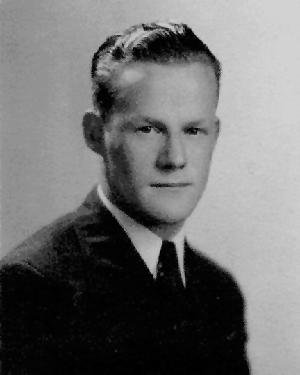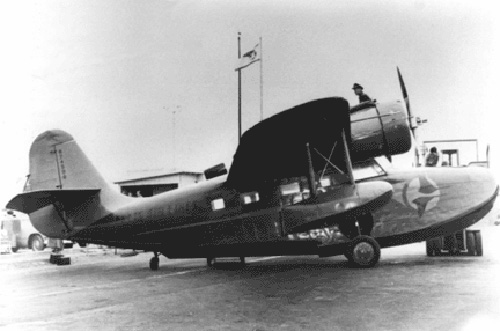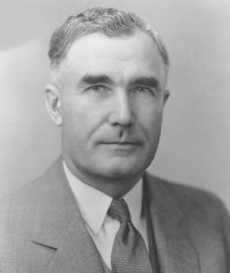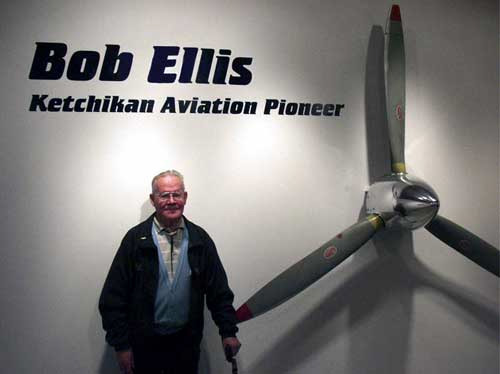
Death of other flyers helped him and passenger survive By DAVE KIFFER October 31, 2011
First of all, there are “routes” that many pilots follow, especially in the most challenging areas, particularly the narrow mountain passes that connect Alaska. And there are also the tragic situations in which a plane will crash while a pilot is searching for another plane, often when going in closer after spotting the potential wreckage of the first crash.
But the odds of two completely unrelated crashes taking place at the same small coastal location are akin to lighting striking the same person twice. Yet, that was just the case 70 years ago this fall and it involved one of Ketchikan’s most famous pilots, Gerald “Bud” Bodding, also known as "Father Goose," for his decades of piloting Grumman Goose amphibians for Ellis Airilines. In the 2010 book “Alaska’s Father Goose” published four years after Bodding’s 2006 death, he calls the dual crashes in October 1941 on British Columbia’s Salal Island “one of the strangest adventures in the flying history of the north.” Salal Island is three by five mile island adjacent to Lady Douglas Island in Milbanke Sound, one of the few open stretches of water on the Inside Passage. It is north of Vancouver Island just off the Queen Charlotte Sound. It is roughly half way between the small communities of Bella Bella and Klemtu. On October 20, 1941, Bodding had left Seattle after a month’s vacation. He was piloting a single engine Waco float plane that he was planning to deliver to a friend in Alaska. His passenger was an Oregon banker named Harry Sherman, who just happened to be the brother of Ellis Air Line’s maintenance vice president Jack Sherman. They left Seattle around noon and then spent the night at Alert Bay, near the north end of Vancouver Island. The next morning, it was cloudy and they received a fairly non-committal weather report from Canadian officials, Bodding wrote. But it sounded like the weather in Prince Rupert was okay so they took off anyway. “ ‘Keep your eye out for Chuck Gropstis,’ said the Alert Bay customs man as we left his office,” Bodding wrote. “’He and Livingston Wernecke are flying down from Alaska today.’” Bodding was an old friend of fellow pilot Gropstis, who had a familiar Bellanca 31 floatplane. Gropstis was the personal pilot for Wernecke who had several mines in Alaska, the Yukon and Northern BC. “I knew their Bellanca well and figured we would waggle wings at each other if our paths crossed on the flight,” Bodding wrote. Not long after leaving Alert Bay, the fog rolled in and Bodding was forced to fly lower. They passed Bella Bella and the fog really hit them at Milbanke Sound. They still had a couple of miles of visibility, with a 100 foot ceiling over the sound so they continued. But when they dropped down to 100 feet over the water, the engine quit without warning. “We’re going down, I yelled to Harry,” Bodding wrote. “A whisper would have been sufficient in the church quiet cabin. If he answered I do not know what he said.” With only 100 feet of altitude to work with, Bodding chose to land downwind in order to be closer to one of the small islands. They landed in the rough water and Sherman was knocked unconscious. The plane started to fill up with water, but Bodding managed to drag Sherman out of the plane and onto the pontoons.
Bud Bodding standing on top of Ellis plane - Date unknown
After about half an hour, Sherman regained consciousness, although he was still bleeding heavily from a head wound. It was then that Bodding was stunned to hear another plane engine in the fog. In the haze he recognized Gropstis’ Bellanca approaching them. Bodding and Sherman waved frantically, but the plane passed by without apparently seeing them in the water. Then the plane engine grew louder and Bodding thought it had seen them and turned. But that was not the case, the plane was now heading north. “Probably they had turned because of worse weather to the south,” Bodding wrote. “Possibly they were heading back to a sitting down spot, in which to wait out the fog. How I envied those lucky guys up there.” But then things changed dramatically as Bodding watched the plane bank toward the small island nearby. “I did not see what happened next, but from the ripping, tearing thud that echoed across the waters, I knew they had cracked up at full speed somewhere on that tiny isle,” Bodding wrote. Slowly they drifted closer to the island. At one point, Sherman undid a belt that was holding him to the pontoon and slipped overboard, then announced he was swimming to shore. Bodding noticed they were about 75 feet from the island and he slipped over and began swimming as well. “Then luck, which had deserted us in the air, found us again in the water,” Bodding wrote. “Half way to the beach my feet touched the bottom.” There was a shallow shelf in the water and they were able to walk to the shore rather than chance the waves and boulders ringing the island. When they reached the island, Bodding wanted to look for the downed Bellanca but Sherman hadn’t heard the plane pass over. Sherman wondered if Bodding had imagined it because Bodding was also bleeding from a head wound that he had not noticed. Both men were growing weaker as they lost blood. “But injured or not, I knew I had heard the Bellanca come down on this island,” Bodding wrote. “If the ship’s passengers still lived, they probably needed our help. Alive or not, they could help us. Surely they had something in the way of survival gear on the plane.” They searched the island for some time and it began to get dark. Finally Bodding found the wreckage. Both Gropstis and Wernecke had been killed and were still strapped in their seats. Bodding surmised that they died on impact.
“Satisfied we could do nothing for our friends, we set about the unpleasant but practical task of searching the plane,” Bodding wrote. “We found a gold mine of supplies.” They found sleeping bags, a tent, emergency rations and a working radio receiver. There was also a gun, but no ammunition. “As we organized our camp, I wondered at our phenomenally good fortune,” Bodding wrote. “The chances for two such near simultaneous crashes must be one in a billion… I wondered, too, why we, and not the two men in the plane, had lived to now have some real hope for survival. Fate must have flipped a coin, I thought, and we won the toss.” The two men settled in to await rescue, which Bodding noted could be in hours or weeks. They rationed their food and also sparingly listened to the radio, noting that the Gropstis plane was reported overdue but no one seemed to know that they were also “missing.” The fog remained heavy and there was no sign of search planes. By the third day, they were pondering trying to get to a lighthouse that they knew was around 13 miles away. Then the fog began to rise and they saw planes and ships in the distance. They set fires and tried to attract attention, unsuccessfully. The third day, Friday, October 24, 1941 was also the day that the Ketchikan newspapers began to cover the missing flyers. That day, the Ketchikan Chronicle ran a headline across its entire front page “Canadian Air Force and Cutter Cyane Search for Two Unreported Planes” followed by smaller headlines “Bud Bodding is Overdue Here” and “Livingston Wernecke’s Private Plane Missing On Alert Bay Hop.” The Chronicle reported that Wernecke’s plane had left Hyder at 9 am on the 21st and had been last sighted flying south near Butedale and that Bodding’s plane, which he was planning to deliver to Tony Schwamm of Petersburg, had been seen by the steamer Tongass near Bella Bella, also on Tuesday. “Local flyers believe the two planes may be together since the last places they were seen, Butedale and Bella Bella are not far apart,” the Chronicle reported on the 24th. But even if Bodding knew, from the radio, that the searchers were looking, it was still disheartening to keep being missed. “Believe me, it actually makes you physically ill, being trapped that way, watching help appear on the horizon, only to see it ignore your most frantic efforts,” Bodding wrote. “Two men never felt lower.” The fourth day was clear and warm and the steamship North Sea passed by, without seeing the men or their signal fire. As they continued to gather wood for fires, the men decided that soon they would build a raft. That night, they also finally heard on the radio that searchers were also looking for them. “All hope has now been abandoned for the also missing Gropstis-Wernecke plane, “ Bodding reported the Canadian announcer saying. “There is some talk among officials that this aircraft may have collided in midair with the Bodding-Sherman Waco.”
Former Ellis Airline's chief pilot, Bud Bodding poses next to a three-blade Goose propeller that greets visitors to the Bob Ellis exhibit at the Tongass Historical Museum.
Bodding said that the experience of being marooned on the island before the rescue changed him. “For a youth of twenty-four, I became awfully philosophical that night (the night before rescue), but in the years since I have tried to keep those thoughts in mind,” he wrote decades later. “And as vice president-chief pilot of Ellis Air Lines, I like to think that our 25 million scheduled passenger miles of death free flying had something to do with those two crashes on Salad Island. I like to think my experience there made a better pilot of me, one more cautious and respectful of weather and that my standards have affected our other pilots, too.”
Editor's Note: Bud Bodding passed away on May 6, 2006. He was 88 years old.
On the Web:
Contact Dave at dave@sitnews.us
Publish A Letter in SitNews Read Letters/Opinions
|
||||



